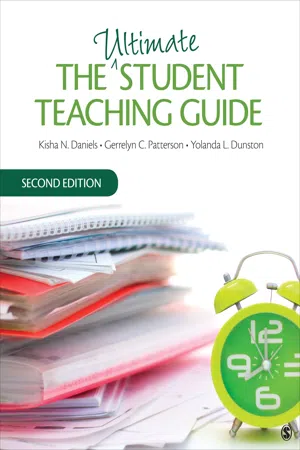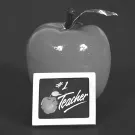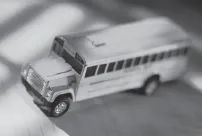
eBook - ePub
The Ultimate Student Teaching Guide
- 224 pages
- English
- ePUB (mobile friendly)
- Available on iOS & Android
eBook - ePub
The Ultimate Student Teaching Guide
About this book
Concise and focused on practical strategies, this engaging, lighthearted guide provides teacher candidates a road map for negotiating the complex and diverse terrain of pre-K through 12 schools, while providing opportunities to develop the skills of reflection that are crucial to becoming a successful practitioner. The Second Edition provides practical, research-based, field-tested strategies that student teachers can immediately apply as they encounter school concerns, solve classroom challenges, negotiate social conflicts, and, new to this edition, navigate the job search and interview process. Concluding chapters challenge readers to view student teaching as a process and to use reflection as a tool for professional growth. Thoroughly updated throughout, the Second Edition includes expanded coverage of workplace professionalism, an introduction to accreditation and the Common Core standards, and more.
Frequently asked questions
Yes, you can cancel anytime from the Subscription tab in your account settings on the Perlego website. Your subscription will stay active until the end of your current billing period. Learn how to cancel your subscription.
At the moment all of our mobile-responsive ePub books are available to download via the app. Most of our PDFs are also available to download and we're working on making the final remaining ones downloadable now. Learn more here.
Perlego offers two plans: Essential and Complete
- Essential is ideal for learners and professionals who enjoy exploring a wide range of subjects. Access the Essential Library with 800,000+ trusted titles and best-sellers across business, personal growth, and the humanities. Includes unlimited reading time and Standard Read Aloud voice.
- Complete: Perfect for advanced learners and researchers needing full, unrestricted access. Unlock 1.4M+ books across hundreds of subjects, including academic and specialized titles. The Complete Plan also includes advanced features like Premium Read Aloud and Research Assistant.
We are an online textbook subscription service, where you can get access to an entire online library for less than the price of a single book per month. With over 1 million books across 1000+ topics, we’ve got you covered! Learn more here.
Look out for the read-aloud symbol on your next book to see if you can listen to it. The read-aloud tool reads text aloud for you, highlighting the text as it is being read. You can pause it, speed it up and slow it down. Learn more here.
Yes! You can use the Perlego app on both iOS or Android devices to read anytime, anywhere — even offline. Perfect for commutes or when you’re on the go.
Please note we cannot support devices running on iOS 13 and Android 7 or earlier. Learn more about using the app.
Please note we cannot support devices running on iOS 13 and Android 7 or earlier. Learn more about using the app.
Yes, you can access The Ultimate Student Teaching Guide by Kisha N. Daniels,Gerrelyn C. Patterson,Yolanda L. Dunston in PDF and/or ePUB format, as well as other popular books in Education & Education General. We have over one million books available in our catalogue for you to explore.
Information
Part I
People
| 1 | Welcome to Student Teaching |
The Open House
Dear Student Teacher:

While these questions are all relevant, you may not have thought to ask yourself additional questions: What is the school culture? Who is the principal? What is the role of parent involvement at the school?
Every school has its own unique spoken and unspoken way of doing things. These rules can present themselves as specific policies in the teacher handbook or as vague guidelines for workplace etiquette. We’ve observed student teachers in many diverse schools, and some of the best student teachers struggle with this transition. So trust us when we say that you’ll want to read this chapter thoroughly (we won’t waste your time with useless information). In our experience, understanding these politics (or at least knowing the questions to ask) can help you realize how you fit into the system and provide you with the first of many steps toward a successful experience.
Sincerely,
Your School Culture Coaches
CHAPTER OBJECTIVES
After reading this chapter, you will be able to
• define the importance of school culture;
• appreciate how school culture affects the organizational structure of schools;
• recognize the legal and ethical issues surrounding the teaching profession;
• identify the various functions of school employees; and
• describe the dos and don’ts of workplace professionalism.
SCHOOL CULTURE
What Is School Culture?
The concept of culture refers to a group’s shared beliefs, customs, and behaviors. A school’s culture includes the obvious elements of curriculum and policies, as well as the social interactions that occur within those structures that give a school its look and feel. This look and feel often lead to school labels, such as “friendly,” “elite,” “competitive,” “inclusive,” and so on. Frequently, it is the unwritten rules about interactions, problem solving, and decision making that give schools a “unique character,” and almost everything in a school can have a set of unwritten rules about how to behave. These unwritten rules often reflect what the school and staff members care about (school mission and/or philosophy), what they are willing to spend time doing (actions in the classroom and parent involvement), how and what they celebrate (career accomplishments, birthdays, weddings, births, etc.), and what they talk about (the all-important school newsletter and teachers’ lounge conversations).

School culture is not about
• Race: The categorization of humans into populations or ancestral groups on the basis of various sets of heritable characteristics
• Socioeconomic status (SES): A measure of a person’s work experience and of an individual’s or family’s economic and social position relative to others, based on income, education, and occupation
• Size of the school: The population and whether it is considered large or small
• Religion: A set of beliefs concerning the cause, nature, and purpose of the universe
Let’s make this conversation a little more tangible. Think about your family and all of the habits, relationships, celebrations, and kitchen table conversations that make it unique. Would you ever say that your family is like every other family? Absolutely not. It may seem difficult to understand why one family celebrates the Christmas season throughout the year (really—365 days, Christmas tree and all), or why a family enjoys going ice fishing as a tradition on birthdays, or the unusual practice of another particular family who hurl dinner rolls across the table instead of calmly passing around the breadbasket. It might be easy to judge these families if their experiences are vastly different from yours. Are these customs considered bad manners or just common courtesy? Would a visitor from another family instantly understand the unwritten rules of your family? Probably not at first, but over time the family choices would become quite clear to visitors because either: (a) they stay for an extended time indicating they agree with and appreciate your family’s ideas and practices, or (b) they thank you for the evening and sneak out the back door, never to be seen again.
In either case, you probably agree that knowing some basic elements of culture helps others understand how your family “does the things that they do.”
We trust that no one will be throwing dinner rolls at you as you walk into the school cafeteria, but what they will be doing remains an open question. How will you know what is valued and expected of you in the school where you will be spending the majority of your waking hours for the next 10,000 weeks? (Just kidding; the length will vary by program.) And if you find out, why does it matter?
Why Is School Culture Important?
Have you ever heard the saying, “What you don’t know might hurt you?” Well, you may want to replay this phrase as you think about the “unwritten and unspoken rules” of the school where you will complete your student teaching internship. This will be helpful as you understand and find your place in this new family. By focusing on the importance of school culture, it is our intention to give you some points to think about as you prepare for and establish yourself in the student teaching experience. Throughout this guide, we refer to the uniqueness of the student teaching experience. There is no place where the uniqueness of this experience is more apparent than in understanding how it is connected to the culture of your placement school. This sentiment is echoed by Cherubini (2009), who found that the student teaching experience is often marked by tensions relating to the difference between teacher candidates’ expectations of school culture and their observed realities. He further noted that this is due mostly to the unique and distinctive circumstances of the student teaching practicum.
For a moment, let’s discuss these unique circumstances:
• Student teachers are not paid employees of the school system,
• Student teachers are expected to fulfill the vast majority of the same responsibilities as teachers (within legal parameters),
• Student teachers are acknowledged as part of the staff, but may not be afforded the same privileges,
• Student teachers are students, and
• Student teachers are also viewed as professionals (and expected to act as such).
School Culture and School Roles Work Together
The student teaching experience typically puts you in a problematic spot where you often straddle the fence (or live in the two worlds) as both student and teacher. In order to hurdle the fence, you must teach for a predetermined amount of time under the supervision of a certified teacher; thus, we now have your new title of student teacher (ST). You don’t have the same privileges as your cooperating teacher (CT), who is an experienced teacher selected to be a mentor, model, and guide, or the other teachers in the building, but you are expected to live by the same rules—whether they are spoken or unspoken. You could say that you are being held to a higher standard because you need to prove yourself, whereas the other teachers and staff already have their seal of approval—a signed employment contract. (However, if you are a lateral entry teacher, you may have other unique circumstances that we address throughout the book, so keep reading.) Since you probably didn’t have the luxury of selecting the school (or the culture) of your student teaching experience, you need to take the steps to ascertain information about the school culture and get some immediate on-the-job training as to how to fit in. Specifically, you want to think about the ways in which the school culture impacts the following:
• The school’s mission statement, which is a formal, short, written statement of the purpose of a company or organization (What are the academic goals? How does the school involve families?)
• The school’s roles (What are the various school roles? Who does what job?)
• The school’s relationships (What type of decision making is valued? How are conflicts handled?)
• The school’s workplace professionalism, wh...
Table of contents
- Cover page
- Halftitle
- Title
- Copyright
- Brief Contents
- Detailed Contents
- Preface
- Acknowledgments
- PART I. PEOPLE
- PART II. POLITICS
- PART III. PLANNING
- PART IV. PERFORMANCE
- Glossary
- Appendix A. Twenty Ways to Say No (or Not Right Now)
- Appendix B. Sample Pacing Guides
- Appendix C. Sample Lesson Plan Templates
- Appendix D. Sample Résumé
- References and Further Readings
- Index
- About the Authors
- Advertisement